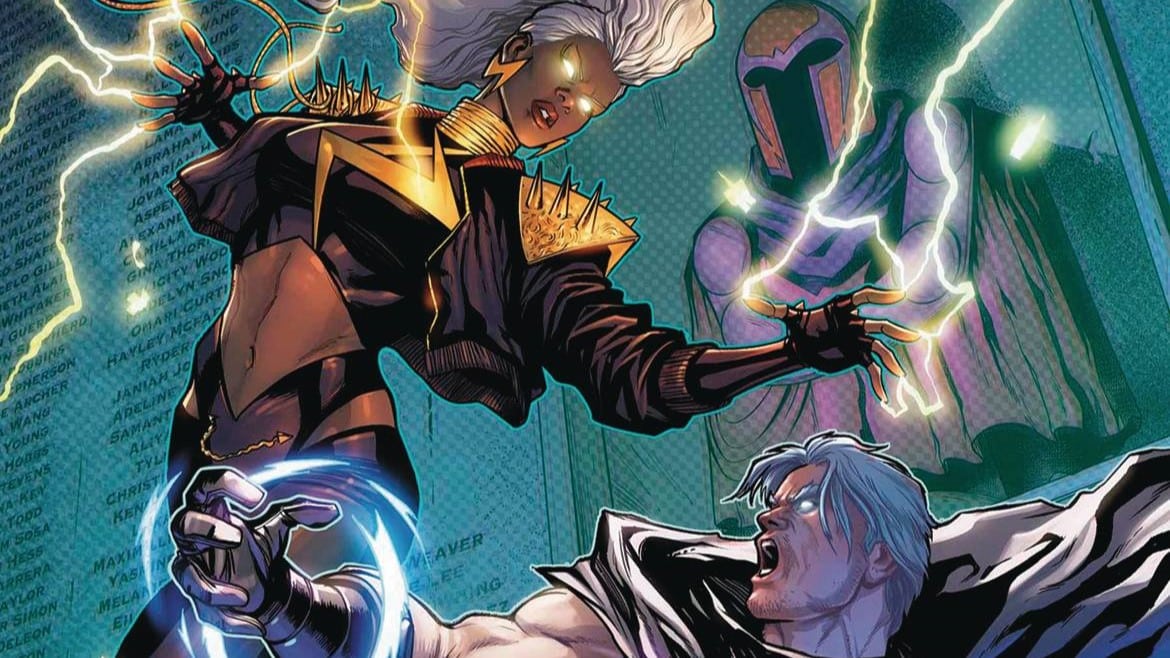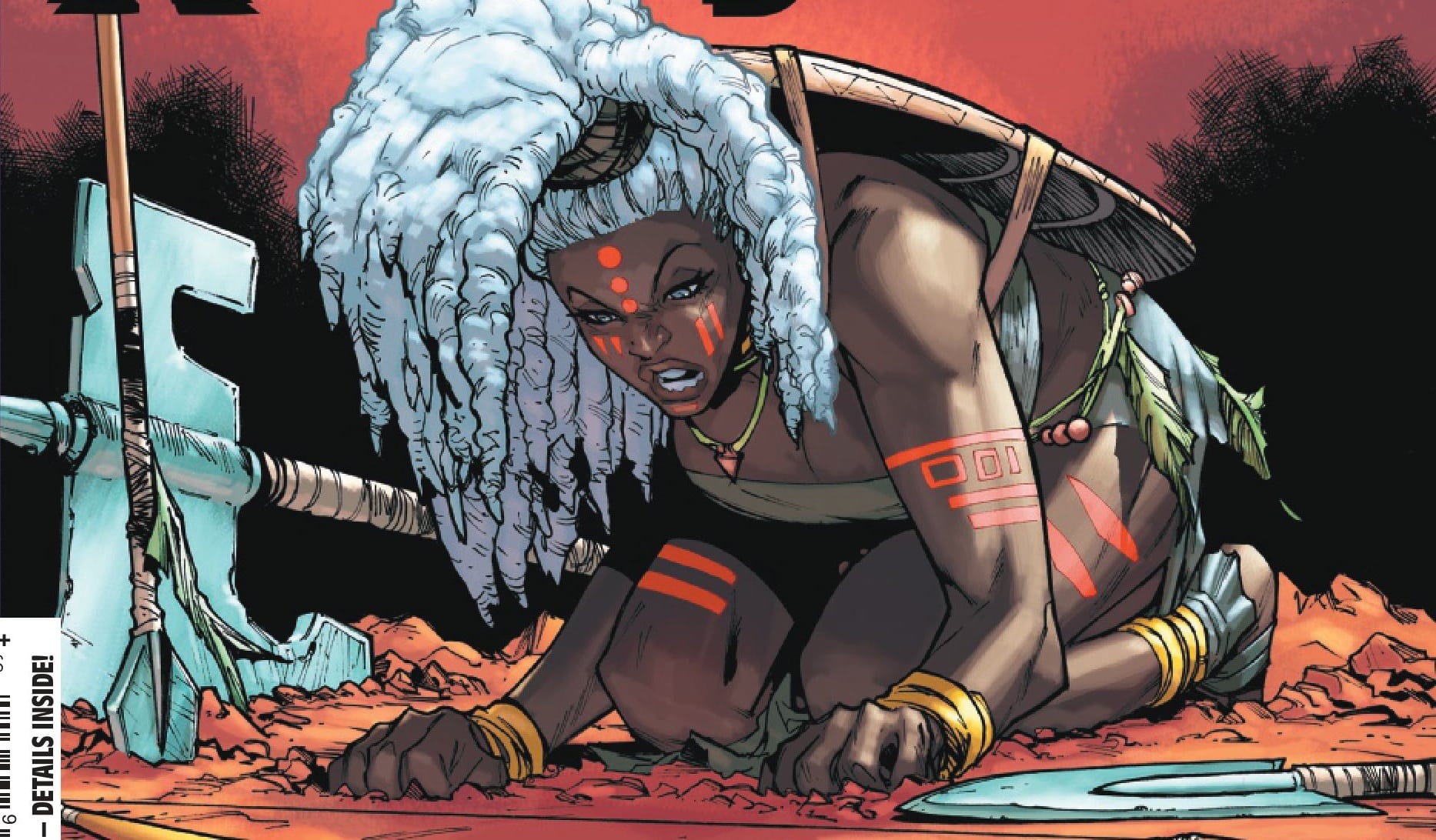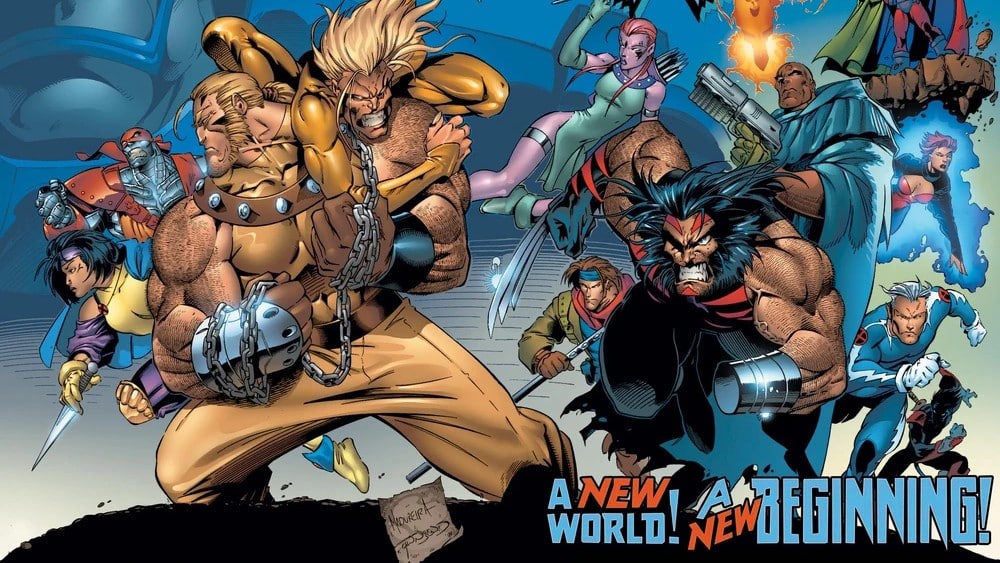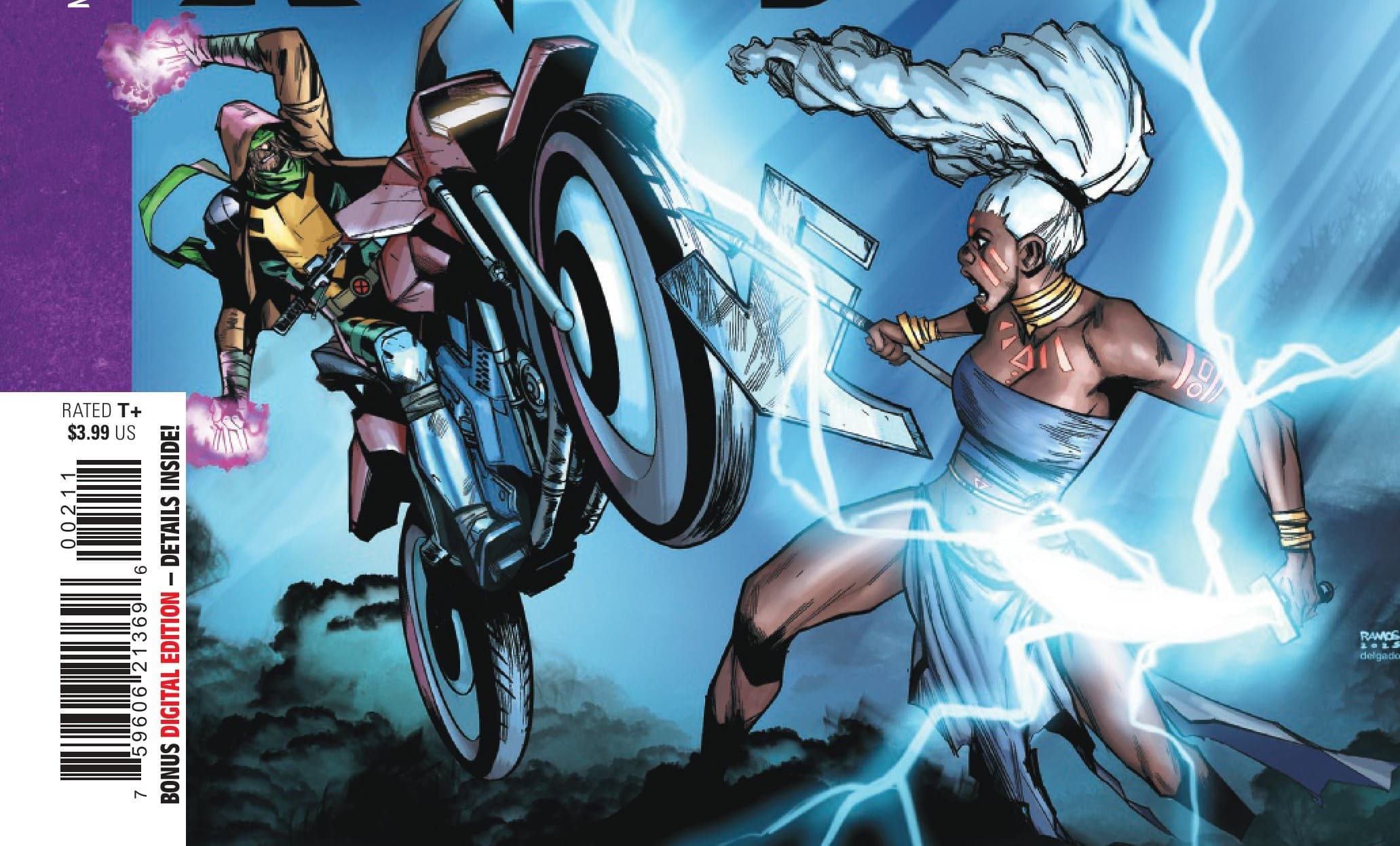Magneto faces the sins of his past — and opens a door via a seemingly-forgotten key — in Resurrection of Magneto #2 written by Al Ewing, drawn by Luciano Vecchio, colored by David Curiel and lettered by Joe Sabino.
Alone in a darkened room, illuminated only by mistakes, an old man finds himself unable — unwilling — to move. Paralyzed by guilt accumulated over years, decades…generations of selfishness and self-righteousness, he’s entombed himself in a prison of his own making, a metal casket engraved with the names of all his sins.
And yet, despite his derelict condition, a part of him — be it out of self care, or more of that wretched self-righteousness — calls out to her. Not to his best friend, or the daughter who possesses his powerset, nor to the adopted child who created an entire afterlife for mutants — no, he calls out to the one whose power, above all, is compassion.
Science fiction is simply an if/then statement. If a certain set of things are understood to be true — lasers can arise from eyes, diamond can calcify over skin, metal is pliable by mental means — then what would happen? If a set of people became superpowered, given the proclivities and prejudices of the world we live in, how would people react?
Good science fiction focuses more on the “then” than the “if”: it doesn’t really matter how people got these powers, or how they work. What really matters is the realism and empathy these powers communicate. What really matters is how we connect to those foreign powers as allegories of things we see in society
Or things we see in ourselves.
I cannot bend metal, nor have I died. But my people have been hunted for who we are. I have been angry, oh so angry, or so tired, of seeing my people hurt.
I have lashed out in avarice, and in pride. I have hurt people. I hurt myself. I have entombed myself in a prison of my own mistakes, flagellating myself, separating myself, hurting myself out of guilt and anger and…
I have cried out for a friend to save me. And she, kindly, patently, honestly, also opened my eyes.
So yes, The Resurrection of Magneto #2 is good science fiction.
It has to be.
How else could I see myself so clearly?
“Do You Care At All What This Does?”

There’s a common grievance among X-fans about Jonathan Hickman’s departure from the X-lines — the idea that many of the grand ideas he seeded were killed off before they took root.
Al Ewing takes one of these seeded ideas — a key taken from the depth of the sea during an expedition with Namor — and uses it to unlock the story in Resurrection of Magneto #2
In the original text, found in Giant Sized X-Men: Magneto, the key appeared to be some kind of MacGuffin, an ancillary prize, a spoil of choosing correctly. There’s nothing to imply the key was intended for the more intimate usage we find here..
But, ”what may have been” doesn’t matter; what is, is all we have. Here, this MacGuffin becomes something personal and affecting — a constant weight that stayed with Magneto to and through death (also: finally a reason to use one of those pouches), as an entryway to (or exit from!) the judgment and purification.
I appreciate Ewing for tying up a loose end with a callback, making that MacGuffin a magnificently symbolic mechanism for telling a truth about self-torment:
We all carry the weight of the key that can free us from judgment and give us absolution.
But do we dare use it?
Life After Death

The National Memorial for Peace and Justice, in Mongomery, Alabama, lists over 4,400 names of the lynched. One day I hope to see it, to pay homage to the ancestors — some of whom may have shared my blood — with candor and care.
And yet, I often wonder: those 4,400 people did not just spontaneously die. They were killed. Intentionally. Violently. Savagely. And the people who did those killings — and their friends, and their children, and their benefactors — almost certainly have not, nor will they walk those hallowed halls.
Thus why I appreciate Magneto’s walk through the memorial of his mind: he acknowledges his misdeeds, all of them, by name: from the notable (Douglas!) to the obscure (Micheal Columbus!). He acknowledges the sham trial of Sabretooth and the subsequent mishandling of the Exiles. He laments, with great specificity, those caught in his arrogance, from those dead by happenstance to those directly affected by his violence (which includes those killed when he was kinda Xorn – it’s a long story.) His willingness, eagerness, to acknowledge, if not own up to, his misdeeds is supposed to be commendable…
But
Is it genuine, or is it theater?
Does he seek accountability, or does he need — desire — to be seen as the martyr under self-imposed contrition?
Storm asks as much, directly, which is why I suspect she — not Wanda, not Polaris, not Xavier — is here. Those three, suffocated by their complex emotions towards Magneto, might have given him the benefit of the doubt. Storm, not despite but because of her compassion does not — which is also why I suspect his feelings are genuine. He didn’t want pity, he’s finally ready for honesty, and his (sub?)consciousness reached out to the one person he trusted to be an honest arbiter.
Their relationship here feels almost maternal: he, the petulant child, throwing a tantrum, crying loudly, cursing and screaming at the top of his lungs.
Her, the mother (always a mother, always the mother!), understanding his temperament for what it is: not a threat, but a cry for care.
The story of X-Men over the Krakoan age shows how the arrogance of men (“just look at what we have made”) has been ameliorated by the leadership of strong women — for better (Emma) or worse (Genesis).
Her presence here is undoubtedly for the better — to remind him that yes, he is his mistakes, but he is more than his mistakes — he is his successes as well.
And those successes — those lives saved — are just as significant as the lives lost.
Magneto, the hero whom Exodus exalted, is real. The headmaster to the New Mutants is real. The good deeds do not necessarily outweigh the bad — and the text does not imply that one overtakes the others
Just that both are real and true.
Had this been the first issue of the run — or the only issue — then I would argue Storm would fall victim to the magical negro trope of helping white characters become better people. But the first issue, in its brilliance, in its centering of Storm, in showing how this journey is as much about her as it is Magneto. Again, Al Ewing is giving a master class in how to write three dimensional Black characters as a white creator, and I desperately hope those coming after this swan song take notes.
Into the Light, Towards the Shadow

I saw myself so well, too well, here, as Magneto finally opened his eyes and looked upon the lives he’s saved. A soft tear left my eye. That tear does not travel down my cheek if the moment isn’t expertly illustrated. Luciano Vecchio continues to do masterful work, allowing the reader to lose themselves in pained character expressions, expertly translating occult-laden tarot cards to the page. While the colors still feel a little flat (likely purposely in some places), and the imagery feels maybe a little less ambitious than the first issue, everything still just works here so well, it’s a shame we won’t get much more of it.
And of not getting more: the ominousness of Magneto noting that this resurrection feels like it might be the last one, of course, works on multiple levels. In the story, without knowing where The Five are, the old ways of resurrection are off the table, sure. But if you’re on this website, reading this article, then you almost certainly know that Krakoa is barrelling towards a conclusion, with a new creative team and new vision around the corner. And as the teases of that new vision feel (needlessly) familiar and (offensively) regressive, this resurrection feels as much like a last hurrah as it does a rebirth. Magneto takes that weight on his shoulders, turning the key, willfully accepting the price he’s more than aware he will have to pay.
Because of course, since this is comics, nothing comes easy, and nothing is simple. So that key of judgment and purification leads directly to a place of Shadows, ruled by a King who’s all too happy to have Magneto (and Storm particularly) in his clutches. From Vita Ayala’s (masterful) work on New Mutants, we know Amahl Farouk expunged his connection from the Shadow King, leaving the multiversal manifestation of nightmares without a host.
Note how the Shadow King cuts directly to the chase here, instantly assessing his foes’ emotional weaknesses (Storm’s tenuous connection to community, Magneto’s continued, contradictory desire for absolution and the awe of crowds).
The die is yet again cast: the heroes are again pitted against an all-knowing villain in a realm where ideas and resoluteness, not mutant gifts, reign supreme.
We can be reasonably certain that our heroes will succeed — solicits never lie, right? Still, how that success will be gained, and the cost of that success are still very much uncertain. That I am still interested — more interested — despite knowing that the end is near speaks to how excellent this work is.
For I know myself; I know how I should look, and I’m all too familiar with the contours of my face, yet I still look in the mirror everyday, checking for something new, eternally surprised, and appreciative of what I find.
The Resurrection of Magneto #2, then, makes a mighty fine mirror. I hope you enjoy what you see.
Magnetic Musings
- The Krakoan on the final page says “Shadows.” Of course it does.
- There are, yet again, more instances of tarot cards being used as basis for pages. The very first page, with B and J on the pillars, references the High Priestess. On the 7th page, with Magneto laying prostrate on a river of fire, his helmeted visage staring back at him – the Five of Coins. Again, knowing the Tarot isn’t necessary to enjoy, but their meanings (self evaluation, awakening, reckoning for the Priestess; a grim situation, filled with ambivalence or indecision, from which you won’t soon emerge for the Five) add depth to the overarching narrative.
- Where the heck *is* Namor?
- Magneto’s relationship with religion is complicated; his original assessment of humanity was based on how they treated his people; his hatred towards humans comes from experiencing the depths of sadism they’ll confine those who they deem different. Emerging from that experience — because of those depths — he severed himself from any concept of God. But religion is not just belief; it’s a learned culture, it’s a history, it’s a comfort. Thus it’s interesting to see him, still separated from belief, reflexively clinging to some of its tenets as he’s on the other side of life.
- Storm’s hair here serves as her cape, showing motion, action, power and calm. Such a shame that it looks to be going in favor of a less emotive, artistically inferior, and culturally-offensive style.
- And of Storm — her shock at learning about Magneto’s (and Toad’s) subterfuge is a stark reminder that many, many loose ends still need to be wrapped up. She, of course, doesn’t know Toad (and the Exiles…and Sabretooth) are free, but her horror of an innocent man imprisoned is palpable (and in character.)
- In the first issue, note that Ashake was able to read Storm’s mind — shown to us as text in blocks. One wonders if Storm isn’t able to do a bit of that here as well.
- When his eyes finally open, the tears of blood instantly become water — another reminder that this place is a moving emotional metaphor.
- Finally, a bit of unwelcome speculation that I’m hoping can be ignored: Storm is not on Arakko. In X-Force, Beast is aiming a gun at Arakko to turn it into a black hole to “protect” the mutants there. Many of the more well-known mutants are off the planet. I’m hoping the end for Arakko would not be so disrespectfully meek. And yet, like Magneto, I lost faith in (comic) Gods a long time ago.
A proud New Orleanian living in the District of Columbia, Jude Jones is a professional thinker, amateur photographer, burgeoning runner and lover of Black culture, love and life. Magneto and Cyclops (and Killmonger) were right. Learn more about Jude at SaintJudeJones.com.






